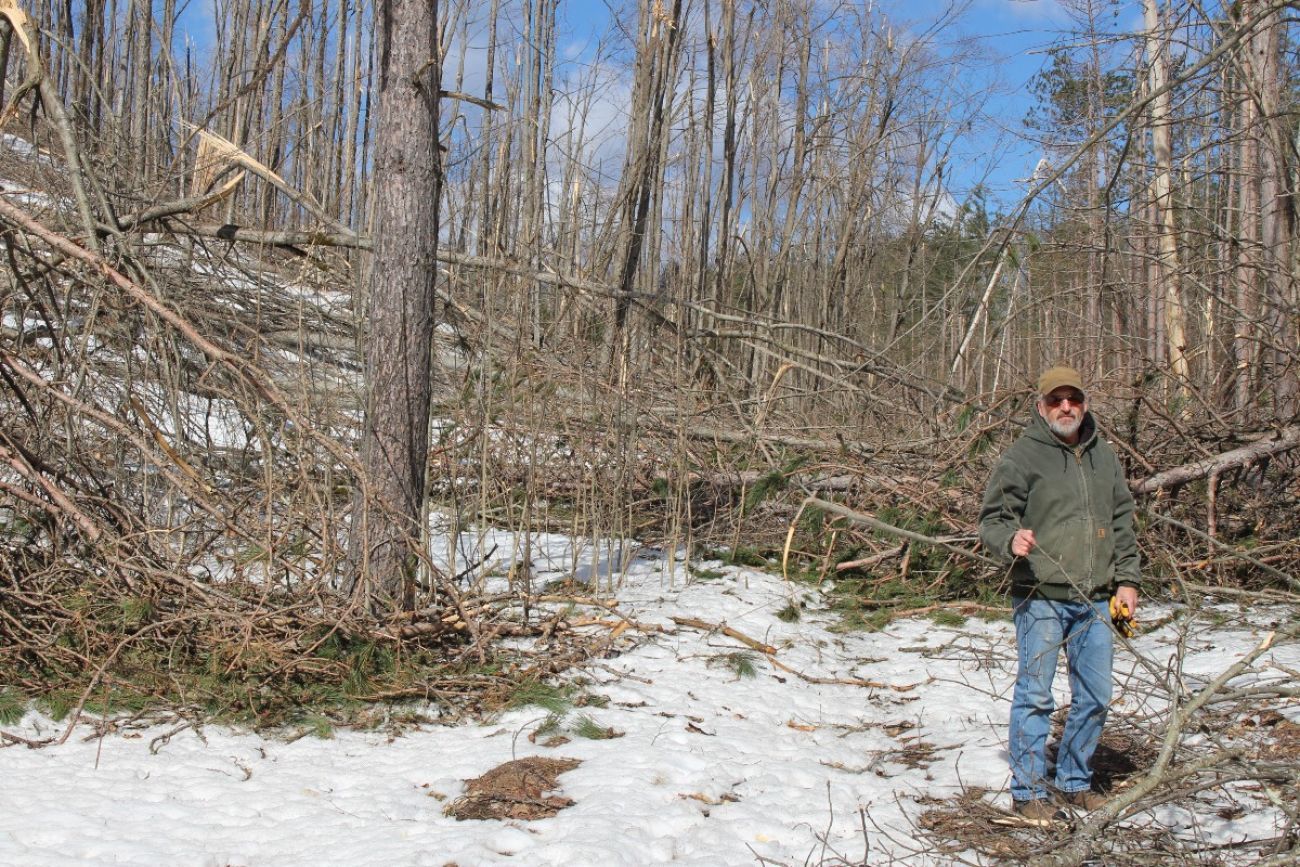As farmers wait on government ice storm relief, nonprofits take charge

- A nonprofit in northern Michigan aims to raise $200,000 to help farmers repair damaged property after a devastating ice storm in March
- Meanwhile, farmers and other residents are waiting to see if the state approves a $100 million relief package and if federal aid will come in
- The money up for grabs pales in comparison to the total damages caused by the storm
After a once-in-a-lifetime ice storm tore through northern Michigan weeks ago, David Coveyou woke up to discover trees strewn across his 330-acre Petoskey vegetable farm and fencing ripped from the ground.
Nearly two months later, he’s still working to rebuild while preparing for a busy planting season.
“We’ve spent hours and hours and hours just cleaning up tree damage, and that’s only one part of it,” Coveyou said.
But, with farm staff now needed for seasonal work, he’ll likely have to hire outside help to continue that cleanup — a hefty added expense in an industry with notoriously tight margins.
And he’s far from the only one struggling.
Michigan State Police officials estimate it will cost at least $200 million to recover from storms that encased wide swaths of northern lower Michigan in a thick layer of ice in late March, knocking down millions of trees and damaging homes and businesses.
As Gov. Gretchen Whitmer prepares to appeal to the Trump administration for federal disaster relief funds that may not arrive for months — if ever — a group of Up North nonprofits have launched an emergency fundraiser in hopes of speeding aid to farmers who need immediate repairs.
Days-long and sometimes weeks-long power outages caused by the storm were particularly damaging for farmers, many of whom lost entire plantings of seedlings when their greenhouses lost heat.
RELATED:
- Slammed by northern Michigan ice storm, foresters wonder what’s next
- 30,000 gallons of maple syrup likely lost in historic Michigan ice storm
- Power company: God caused ice storm; we shouldn’t have to compensate customers
Maple syrup producers saw trees ripped to pieces, prompting industry experts to forecast that a third of the state’s annual output has been lost, potentially permanently.
The state House has advanced a $100 million aid proposal that would reimburse communities for emergency supplies, cleanup and repair to damaged public infrastructure. That proposal is also meant to render Michigan eligible for relief dollars from the Federal Emergency Management Agency, which requires a 25% funding match from states.
The bill is awaiting consideration in the state Senate.
Whitmer will soon request a presidential disaster declaration in pursuit of federal aid, said Lauren Thompson-Phillips, spokesperson for the Michigan State Police’s Emergency Management and Homeland Security Division.
There’s no set timeline for how quickly President Donald Trump must act on that request, nor how quickly FEMA money would flow if the request was approved. It usually happens relatively quickly, Thompson-Phillips said, but it took six months for funds to arrive after major flooding hit Michigan in August 2023.
In the meantime, leaders of the northern Michigan nonprofit fundraising effort, organized by the Crosshatch Center for Art & Ecology, the Groundwork Center for Resilient Communities and the Local Food Alliance, are inviting farmers to apply for financial aid to help them repair damaged property.
They acknowledge that the money available —$10,000 so far, with a fundraising goal of $200,000 — is small in comparison to the need.
But “a small amount of money will go a long way,” said organizer Christina Marbury, the community outreach specialist at Crosshatch.
The committee reviewing applicants will prioritize farmers who demonstrate the most need.
“I’m sure those will be very, very tough decisions,” said Jeff Smith, spokesperson for the Groundwork Center. “But we just feel the need to do something.”
Coveyou, the Petoskey vegetable farmer, said he’s considering getting in line.
He estimates it’ll take tens of thousands of dollars to install new fences, an essential tool to keep deer from eating his crops.
It’s the kind of major expense, he said, “that you weren’t really planning on two months ago.”
Bridge regional editor Justin Hinkley contributed to this story.
Michigan Environment Watch
Michigan Environment Watch examines how public policy, industry, and other factors interact with the state’s trove of natural resources.
- See full coverage
- Subscribe
- Share tips and questions with Bridge environment reporter Kelly House
Michigan Environment Watch is made possible by generous financial support from:
Our generous Environment Watch underwriters encourage Bridge Michigan readers to also support civic journalism by becoming Bridge members. Please consider joining today.
See what new members are saying about why they donated to Bridge Michigan:
- “In order for this information to be accurate and unbiased it must be underwritten by its readers, not by special interests.” - Larry S.
- “Not many other media sources report on the topics Bridge does.” - Susan B.
- “Your journalism is outstanding and rare these days.” - Mark S.
If you want to ensure the future of nonpartisan, nonprofit Michigan journalism, please become a member today. You, too, will be asked why you donated and maybe we'll feature your quote next time!






